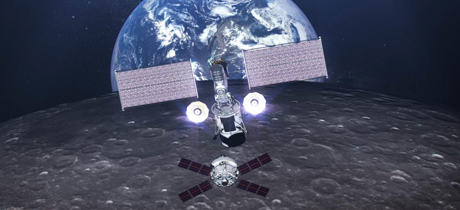In Today’s Deep Space Extra… NASA says a two element lunar orbiting Gateway could be launched by 2023, perhaps as part of a strategy to return to the surface of the Moon with human explorers in 2024.
Human Space Exploration
Lunar Gateway on again for 2023
Coalition Members in the News – Maxar, Northrop Grumman
Spacepolicyonline.com (5/7): NASA is now looking at a strategy to integrate the first two elements of a lunar orbiting, human tended Gateway so they can be placed around the Moon together with a single launch as part of a strategy to accelerate a return to the lunar surface with human explorers in 2024. The initial Gateway strategy envisioned a 2028 return. In March 2019, NASA was directed by the White House to advance the milestone known as Artemis 3 to 2024 in order to establish a sustainable human lunar presence by 2028. Plans for a Gateway as part of the 2024 date faded, but have returned with plans to merge a Maxar Power and Propulsion Element (PPE) and Northrop Grumman Habitation and Logistics Outpost (HALO) prior to liftoff. Once in lunar orbit, Gateway could be equipped with Human Landing Systems (HLS) to shuttle astronauts to and from the lunar surface for the 2024 mission and then expanded with contributions from international partners.
Astronaut-led video tour reveals details in ‘For All Mankind’ Moon Base
Space.com (5/7): One time NASA astronaut and senior advisor to SpaceX Garrett Reisman hosts a virtual tour of a fictional Moon Base, Jamestown. Making historical references to the Apollo exploration era, Reisman asks, “What if the landing on the Moon was just the beginning?”
Return capsule of China’s experimental manned spaceship comes back successfully
Xinhuanet of China (5/8): China’s uncrewed test flight of a new generation human spacecraft ended successfully on Friday, nearly three days after its launch into Earth orbit with a new Long March 5B rocket. Parachutes were deployed after re-entry and six air bags deployed to soften the return to land. The test flight included in orbit experiments and evaluations of flight controls and the heat shield. The spacecraft’s future human missions include flights to a soon to be assembled Chinese space station and exploration of the Moon.
Space Science
NASA’s Perseverance rover spacecraft put in launch configuration
Coalition Member in the News – United Launch Alliance
NASA Jet Propulsion Laboratory (5/7): Now at NASA’s Kennedy Space Center (KSC), the Perseverance Mars 2020 rover is coming together in a launch configuration for liftoff from the Cape Canaveral Air Force Station atop a United Launch Alliance (ULA) Atlas 5 rocket between July 17 and August 5. A carefully configured descent stage is to lower the rover to the Martian surface at Jezero Crater in February 2021. Perseverance is equipped to seek evidence of past habitable environments, gather and cache samples of surface material for a future return to Earth and support the test flight of a small helicopter called Ingenuity.
When did Mars lose its global magnetic field?
Universe Today (5/7): A new study led by researchers from the University of British Columbia suggests the now absent Martian magnetic field appeared earlier and survived longer than previous estimates. Like with the Earth, a global magnetic field acts as a shield that prevents the solar wind from gradually blowing away an atmosphere and other environmental conditions that allow water to flow and pool on the surface, factors that contribute to a habitable environment. The Martian terrain suggests liquid water was once plentiful on Mars. The findings were published in Science Advances.
Russia wants to land 3 next-generation Luna spacecraft on the Moon by 2025
Space.com (5/7): Russia is planning three lunar missions intended to take up where it left off with exploration of the Moon in 1976. The future Luna 25, 26 and 27 missions are to liftoff before 2025, each in partnership with the European Space Agency (ESA), with orbiters and landers designed to map the surface of the Moon and study the composition of the regolith. Future missions could include rovers and plans to gather and return samples of the Moon to Earth.
SpaceX describes exactly how they are planning to make Starlink satellites less visible from Earth
Universe Today (5/6): During a late April presentation hosted by the National Academies of Science, Engineering Medicine, space entrepreneur Elon Musk discussed efforts he’s making with the growing Starlink small satellite broad band network to address orbital debris concerns and complaints from the astronomy community regarding the reflectivity of the constellation that interferes with telescope observations.
Op Eds
Securing America’s small business space sector
SpaceNews.com (5/5): The outsized contribution of small business to the nation’s economy continues to the present and propels America’s revived deep space ambitions. After a half century, America is again at the precipice of reaching outward to the Moon and beyond. Near term decisions by Congress will have consequence for generations and determine whether the nation’s spacefaring ambitions accelerate or atrophy. But if Congress chooses the better path and funds NASA’s budget request, the future benefit will be incalculable.
Other News
Space Force rolls out recruitment video: ‘Maybe your purpose isn’t on this planet’
SpaceNews.com (5/6): Leadership of the newly established U.S. Space Force, the sixth branch of the U.S. military, offers a preview of service to in a recruitment video that sounds an intriguing theme, “Maybe your purpose on this planet isn’t on this planet.”

